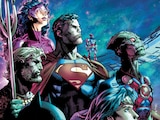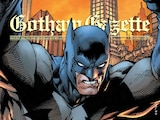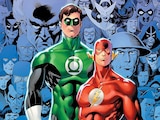Most of the DC Universe has been asleep for the past month, but in their case, it’s been anything but restful.
“Knight Terrors,” the line-wide mega event that has seen heroes and villains like Batman, Green Lantern, Superman, the Joker, Catwoman, Harley Quinn and more trapped in a perpetual nightmare, has now entered its second month, and like with any good horror story, things are only getting tenser and more frightening as it goes on.
They’re also getting a lot more revealing. Already, “Knight Terrors” has shown us things about these characters we never would have suspected. Things that these characters have long kept to themselves, and that they would never willingly reveal to anyone. Ultimately, “Knight Terrors” will end, and we have to think that our heroes will find a way to confront and stop Insomnia, the new villain who’s behind it all. But it’s confronting the truth revealed in these nightmares that will have far deeper consequences.
We recently had a chance to chat all things “Knight Terrors” with core series writer Joshua Williamson, who explained where the idea of the event came from and how it’s been collaborating on such a big storytelling project. He also shed some light on how they landed on the main characters of the series, why they created a new villain rather than going with an established one and what exactly he’d be seeing if Insomnia ever used his power on him.

“Knight Terrors” is such a big, broad event. Whose idea was it and how did you end up writing the main series?
DC came to us last year, before Dark Crisis had even come out. They said they really wanted to have an event next summer—a short, two-month event. So, we started talking about it—me, editorial, some different creators. We had a few different ideas about it and thoughts on things, until one day, I was meeting Ben Abernathy, DC’s Executive Editor, for beer and pizza. I’m driving to go meet with him and as I’m driving, I started thinking about some of the challenges we had. We knew we didn’t want it to be a multiverse story. We knew we didn’t want it to be an alternate reality story. So, how do we get our characters to go someplace different? What could we do?
As I was driving, that word popped in my head: nightmares. And suddenly I started thinking along the lines of “Nightmare on DC Street.” It’s our version of Freddy vs. the DC Universe. So, I met with Ben and I said, “I think I’ve got it—nightmares. The villain pulls them all into their nightmares. It’s two months where everyone’s trapped in their nightmares, and we let everyone have a lot of creative freedom about what that means.”
It becomes a thing about character—what are the different characters’ nightmares? What do they dream about? What are they afraid of? It’s a bit different because nightmares doesn’t necessarily mean your fears. It really became this conversation about each character. Sometimes we have these big cosmic stories, but with this one, it was going to be a little different because it was much more about the characters and what they actually would have nightmares about.
I started putting a document together and we started talking about it and that’s where it came from.

Did this character of Insomnia come out of that? Where did he come from?
We wanted it to be a new villain. I love Doctor Destiny, but with this, I just wanted something different and I feel like we needed another “Big Bad.” DC has a lot of Big Bads, but I think we keep coming back around to them. I thought we should give ourselves another cosmic-level villain, so we started talking about this character and why they were angry, why they were doing this, where they came from, how they were connected to Doctor Destiny and all of these events. We started building out their origin.
We actually see their origin in the Knight Terrors series, but we see it backwards, so by the end you see how they were created and you might think, “Oh, they have a reason to be angry and I might agree with it.”
Is this an event where you’re in touch with some of the other writers working on it, or all you all more or less working independently?
It’s a mix. I feel like I’ve talked to the majority of the writers, but not all. Some I spoke to through the editors. I had a lot of conversations with the editors. I wrote documents up that were very short and easy, laying out the guidelines and rules to follow. I would joke sometimes and say, “If you’ve seen Nightmare on Elm Street, you’re going to be fine.”
Some writers I’m closer to than others, so I would talk to them. And then in a lot of cases, it was editorial—I’d talk through them. Jeremy Adams and I, we know each other. We’d chat throughout the day. Dennis Culver and I are friends, so we’d talk. Phillip Kennedy Johnson and I would talk a lot because of Superman—we texted back and forth. It depended, but I had a lot more talks with editorial, I think.
You’re using a diverse group of characters. How did you decide which characters were going to take on leading roles in “Knight Terrors”?
Well, the first thing we did was look at all of the books that were ongoing. Those were the ones that we knew were going to be paused and be impacted by this event, so we started off there. We talked to the writers and started making a list of characters we thought would be fun to explore. That’s where characters like Ravager came from. And then we thought, let’s take some risks, like Angel Breaker. Then there were ones like Zatanna. I’m a big Zatanna fan and wish we were doing more with her. I think she’s a really cool character, but also an incredibly popular character. I don’t think people realize how popular she is. When I realized that Zatanna’s book would be written by Dennis [Culver], well, Dennis and I are really close, so we talked about it a lot. I knew that I wanted Zatanna to be awake, so we discussed it and came to a really cool story we could tell with her.

What about Deadman?
I just love Deadman.
He does seem to work. Sleeping and death aren’t quite the same thing, but I guess they’re close enough?
They talk about this throughout the book, that there are connections between the two. Insomnia is very similar to Deadman in some ways. The connections are there—how the nightmare stone sort of calls for Deadman. What happened was originally, before we really started getting into it and knew it was going to be an event about nightmares, I had this line in my head: “DC Comics is haunted.” That was my initial thought.
So, if we’re doing a story about DC being haunted…well, Deadman’s a ghost. We started talking about him initially, before we had nightmares involved. Once we settled on nightmares, I remember putting Deadman to the side, thinking about how I really like him and I think he’d be a cool character to do an emotional story arc with, but it’s not going to work with nightmares.
But as I started working on it, I knew I needed a character in there to serve as our POV into this story. I started thinking about different characters, but I just came back around to Deadman. I thought, this is a character that I really like and I think there’s something we can do here. Part of it was me being selfish! I really like him as a character and I had his voice in his head.
Your understanding of his voice to me seems totally spot-on. He’s not quite over the top, but he’s a bit eccentric.
He’s a little kooky, yeah. A little weird. He’s not so serious, but there’s also a kind of showman to him. That’s who he was before—he was a showman. This is a guy who would go out and pretend he was going to die with these death-defying stunts. There’s something about that kind of person. The fact that he is now dead and loving it…or is he loving it? That’s part of what the story’s about. You have this guy that would always put on these shows and he can’t put on a show anymore.

Knight Terrors: Batman, like the other “Knight Terrors” books, delves into the character’s psyche through this dark dreamscape. How do you approach a book like this that’s not literal—where it’s set outside the real world and things are more symbolic?
I love dream logic in stories. I think it’s a really fun thing to play with. It allows you to experiment and do weird things because dreams don’t always make sense. They take you in strange directions and when you wake up, what you remember always feels scattered. So, I wanted to explore that.
The challenge with Batman is that we have covered so much of Batman’s fears and this idea that he’s constantly repeating these things that I actually wanted to make a commentary on that. Batman is so used to having to repeat these things, that’s become his fear—repeating it. Because we’ve seen it all, right? I joke that I’ve seen Thomas and Martha Wayne die so many times. Well, so has Bruce. So, let’s do something different with it this time and actually talk about that.
What can a story about fears teach us about these characters? Why is it such an effective storytelling tool?
Well, again, it’s not really about their fears. It’s about what their nightmares are about, and I feel like those are two different things. You sometimes have nightmares about things that aren’t actually your fears, and I think that can reveal something about yourself—what you’re going through in that moment when you have that nightmare. But it might not actually be your fears.
I was really happy when some of the writers reached out and asked, “Are we doing this literal, or are we going to get figurative and weird with it?”
My answer was, “All of it. You do what is best for your character. There is no rule on this. The weirder and the more fun, the better.”
I do think fears are a powerful storytelling tool. So many stories are about that—I’m afraid of this, but I have to conquer that fear. With this, it really gave us a lot of things to explore, and again, it became about character and less about big explosions and the multiverse.

What’s your biggest nightmare?
I always have nightmares about tidal waves, which they say means that you’re feeling overwhelmed, so that tells you something about me. (laughs)
I’m always overwhelmed. Always doing too much. In fact, I put that work into The Flash and Superman. These are two people who want to do it all and want to save everybody, and I always relate to that and how they’re always trying to do too much. So yeah, when Superman has the nightmare about the tidal wave, that was me putting myself in there!
Knight Terrors #3 by Joshua Williamson, Giuseppe Camuncoli, Stefano Nesi, Caspar Wijngaard and Frank Martin is now available in print and as a digital comic book. Look for Josh’s work in Knight Terrors: Batman and Knight Terrors: Superman as well!















